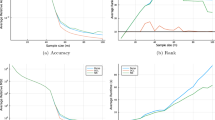Abstract
Rank minimization is of interest in machine learning applications such as recommender systems and robust principal component analysis. Minimizing the convex relaxation to the rank minimization problem, the nuclear norm, is an effective technique to solve the problem with strong performance guarantees. However, nonconvex relaxations have less estimation bias than the nuclear norm and can more accurately reduce the effect of noise on the measurements. We develop efficient algorithms based on iteratively reweighted nuclear norm schemes, while also utilizing the low rank factorization for semidefinite programs put forth by Burer and Monteiro. We prove convergence and computationally show the advantages over convex relaxations and alternating minimization methods. Additionally, the computational complexity of each iteration of our algorithm is on par with other state of the art algorithms, allowing us to quickly find solutions to the rank minimization problem for large matrices.






Similar content being viewed by others
References
Movielens. https://grouplens.org/datasets/movielens/. Accessed: 2019-11-21
Andrew, A., Chu, K., Lancaster, P.: Derivatives of eigenvalues and eigenvectors of matrix functions. SIAM J. Matrix Anal. Appl. 14(4), 903–926 (1993). https://doi.org/10.1137/0614061
Burer, S., Monteiro, R.: A nonlinear programming algorithm for solving semidefinite programs via low-rank factorization. Math. Program. 95(2), 329–357 (2003). https://doi.org/10.1007/s10107-002-0352-8
C. Lu J. Tang, S.Y., Lin, Z.: Generalized nonconvex nonsmooth low-rank minimization. Proceedings of the IEEE computer society conference on computer vision and pattern recognition (2014). https://doi.org/10.1109/CVPR.2014.526
Candès, E., Tao, T.: The power of convex relaxation: Near-optimal matrix completion. IEEE Trans. Inf. Theor. 56(5), 2053–2080 (2010). https://doi.org/10.1109/TIT.2010.2044061
Fan, J., Li, R.: Variable selection via nonconcave penalized likelihood and its oracle properties. J. Am. Stat. Assoc. 96(456), 1348–1360 (2001)
Fazel, M., Hindi, H., Boyd, S.P.: Log-det heuristic for matrix rank minimization with applications to hankel and euclidean distance matrices. Proceedings of the 2003 American Control Conference, 2003. 3, 2156–2162 vol.3 (2003)
Geman, D.: Chengda Yang: nonlinear image recovery with half-quadratic regularization. IEEE Trans. Image Process. 4(7), 932–946 (1995)
Goldberg, K., Roeder, T., Gupta, D., Perkins, C.: Eigentaste: a constant time collaborative filtering algorithm. Inf. Retr. 4(2), 133–151 (2001). https://doi.org/10.1023/A:1011419012209
Hoffman, A.J., Wielandt, H.W.: The variation of the spectrum of a normal matrix. Duke Math. J. 20(1), 37–39 (1953). https://doi.org/10.1215/S0012-7094-53-02004-3
Cai, J., Candes, E.J., Shen, Z.: A singular value thresholding algorithm for matrix completion. SIAM J. Optim. 20(4), 1956–1982 (2010)
Lai, M.J., Xu, Y., Yin, W.: Improved iteratively reweighted least squares for unconstrained smoothed \(l_q\) minimization. SIAM J. Num. Anal. 51(2), 927–957 (2013). https://doi.org/10.1137/110840364
Li, Q., Qi, Hd.: A sequential semismooth newton method for the nearest low-rank correlation matrix problem. SIAM J. Optim. 21(4), 1641–1666 (2011)
Liu, Z., Vandenberghe, L.: Interior-point method for nuclear norm approximation with application to system identification. SIAM J. Matrix Anal. Appl. 31(3), 1235–1256 (2010). https://doi.org/10.1137/090755436
Lu, C., Zhu, C., Xu, C., Yan, S., Lin, Z.: Generalized singular value thresholding. arXiv abs/1412.2231 (2014). arXiv: 1412.2231
Magnus, J.: On differentiating eigenvalues and eigenvectors. Econo. Theory 1(2), 179–191 (1985). https://doi.org/10.1017/s0266466600011129
Mohan, K., Fazel, M.: Iterative reweighted least squares for matrix rank minimization. 2010 48th Annual Allerton Conference on communication, control and computing (Allerton) (2010).https://doi.org/10.1109/allerton.2010.5706969
Rennie, J.D.M., Srebro, N.: Fast maximum margin matrix factorization for collaborative prediction. In: Proceedings of the 22nd International Conference on machine learning, ICML’05, p. 713–719. Association for Computing Machinery, New York, NY, USA (2005). https://doi.org/10.1145/1102351.1102441
Ma, S., Goldfarb, D., Chen, L.: Fixed point and Bregman iterative methods for matrix rank minimization. Math. Program. 128, 321–353 (2009)
Sagan, A., Shen, X., Mitchell, J.E.: Two relaxation methods for rank minimization problems. J. Optim. Theory Appl. 186(3), 806–825 (2020). https://doi.org/10.1007/s10957-020-01731-
Shen, X., Mitchell, J.: A penalty method for rank minimization problems in symmetric matrices. Comput. Optim. Appl. 71(2), 353–380 (2018). https://doi.org/10.1007/s10589-018-0010-6
Srebro, N., Rennie, J.D.M., Jaakkola, T.S.: Maximum-margin matrix factorization. In: Proceedings of the 17th International Conference on neural information processing systems, NIPS’04, p. 1329–1336. MIT Press, Cambridge, MA, USA (2004)
Hastie, T., Mazumder, R., Lee, J.D., Zadeh, R.: Matrix completion and low-rank svd via fast alternating least squares. J. Mach. Learn. Res. 16(104), 3367–3402 (2015)
Tanner, J., Wei, K.: Low rank matrix completion by alternating steepest descent methods. Appl. Comput. Harmonic Anal. (2015). https://doi.org/10.1016/j.acha.2015.08.003
Tasissa, A., Lai, R.: Exact reconstruction of euclidean distance geometry problem using low-rank matrix completion. IEEE Trans. Inform. Theory 65(5), 3124–3144 (2019). https://doi.org/10.1109/tit.2018.2881749
Trzasko, J., Manduca, A.: Highly undersampled magnetic resonance image reconstruction via homotopic \(\ell _{0}\) -minimization. IEEE Trans. Med. Imag. 28(1), 106–121 (2009)
Wen, Z., Yin, W., Zhang, Y.: Solving a low-rank factorization model for matrix completion by a nonlinear successive over-relaxation algorithm. Math. Program. Comput. 4(4), 333–361 (2012). https://doi.org/10.1007/s12532-012-0044-1
Xu, Y., Yin, W.: A block coordinate descent method for regularized multiconvex optimization with applications to nonnegative tensor factorization and completion. SIAM J. Imag. Sci. 6(3), 1758–1789 (2013). https://doi.org/10.1137/120887795
Lou, Y., Yin, P., Xin, J.: Point source super-resolution via non-convex \(l_1\) based methods. J. Sci. Comput. 68(3), 1082–1100 (2016)
Yao, Q., Kwok, J., Zhong, W.: Fast low-rank matrix learning with nonconvex regularization. 2015 IEEE International conference on data mining (2015). https://doi.org/10.1109/icdm.2015.9
Yao, Q., Kwok, J.T., Gao, F., Chen, W., Liu, T.Y.: Efficient inexact proximal gradient algorithm for nonconvex problems. Proceedings of the Twenty-Sixth International Joint Conference on artificial intelligence (2017). https://doi.org/10.24963/ijcai.2017/462
Yao, Q., Kwok, J.T., Wang, T., Liu, T.: Large-scale low-rank matrix learning with nonconvex regularizers. IEEE Trans. Pattern Anal. Mach. Intell. 41(11), 2628–2643 (2019). https://doi.org/10.1109/TPAMI.2018.2858249
Zhang, C.H.: Nearly unbiased variable selection under minimax concave penalty. Annal. Stat. 38(2), 894–942 (2010)
Zhang, D., Hu, Y., Ye, J., Li, X., He, X.: Matrix completion by truncated nuclear norm regularization. 2012 IEEE Conference on computer vision and pattern recognition pp. 2192–2199 (2012). https://doi.org/10.1109/CVPR.2012.6247927
Author information
Authors and Affiliations
Corresponding author
Additional information
Publisher's Note
Springer Nature remains neutral with regard to jurisdictional claims in published maps and institutional affiliations.
This work was supported in part by National Science Foundation under Grant Number DMS-1736326.
Rights and permissions
About this article
Cite this article
Sagan, A., Mitchell, J.E. Low-rank factorization for rank minimization with nonconvex regularizers. Comput Optim Appl 79, 273–300 (2021). https://doi.org/10.1007/s10589-021-00276-5
Received:
Accepted:
Published:
Issue Date:
DOI: https://doi.org/10.1007/s10589-021-00276-5




